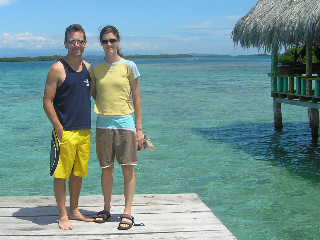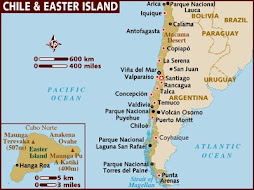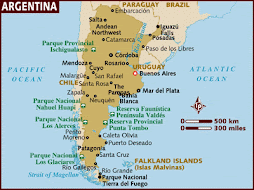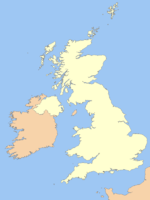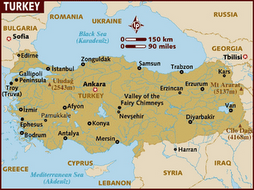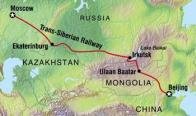Tuesday, November 13, 2007
Home
I've had a fantastic trip, and hope anyone who's dropped in to read this blog has enjoyed seeing a bit of the wonderful places I've visited.
Hasta luego amigos!
Rapa Nui... (Easter Island in English!)
 After a 4hr or 5hr flight over sea, our plane turned beautifully so I got a glimpse of the entire green island with its old volcanoes before coming in to land. And with the endless view of sea, you really do get the sense of isolation that allowed this island to develop its unique culture.
After a 4hr or 5hr flight over sea, our plane turned beautifully so I got a glimpse of the entire green island with its old volcanoes before coming in to land. And with the endless view of sea, you really do get the sense of isolation that allowed this island to develop its unique culture.I quickly found a hostel from the airport info desk, and we were picked up and given a quick tour of town by the owner before being dropped back at the hostel. I spent most of my time on the

 island with Carla, an English girl, who arrived on the same flight and had similar plans on visiting ruins. So we wandered back round town, down to the port area, and along the foreshore to see our first moai (statues) before enjoying a lovely fish dinner.
island with Carla, an English girl, who arrived on the same flight and had similar plans on visiting ruins. So we wandered back round town, down to the port area, and along the foreshore to see our first moai (statues) before enjoying a lovely fish dinner.Next day, after visiting the tourist office, picking up some maps and written guides (and booking our tour for the next day), we headed along the coast in the opposite direction, and up to the volcano and the ceremonial town of Orongo. This route took us past more toppled moai, a small port, a garden of native
 plants, and some ocean caves that were used in "birdman" religious ceremonies. And we reached the crater of the volcano (spectacular) and the archeolical ruins of the town of Orongo known for its birdman ceremonies.
plants, and some ocean caves that were used in "birdman" religious ceremonies. And we reached the crater of the volcano (spectacular) and the archeolical ruins of the town of Orongo known for its birdman ceremonies.OK some history/myths before I go further.... the island was first inhabited by people (probably polynesian) of a "sunken land" who came in double canoes. There was thought to be a second wave of immigration or possibly slaves
 brought from somewhere later. Over time clans and a society developed with some different classes. Somewhere along the way the carving of Moais (statues) and ahus (platforms) developed, with each clan having its own ceremonial centres. The Moais are thought to represent sucessive rulers of the clan, and were thought to have been built up over time. These moais where nearly all carved out of rock from one central quarry and mysteriously transported... It seems production of these maoi went mad... in total theres about 1000 on the island with about a third
brought from somewhere later. Over time clans and a society developed with some different classes. Somewhere along the way the carving of Moais (statues) and ahus (platforms) developed, with each clan having its own ceremonial centres. The Moais are thought to represent sucessive rulers of the clan, and were thought to have been built up over time. These moais where nearly all carved out of rock from one central quarry and mysteriously transported... It seems production of these maoi went mad... in total theres about 1000 on the island with about a third  found near platforms, others in transport or in the process of carving.
found near platforms, others in transport or in the process of carving.Its thought that this moai manufacture and transport led to dramatic deforestation and erosion on the island. And in turn to interclan and class rivalry, where diminishing resources led to clan wars, and eventually all the moai were toppled and several ahus destroyed. (So those we see standing on ahus have all been restored and are not original, just as the grassy and largely treeless land that we see today is
 quite different from the palm groves that researchers say were there.)
quite different from the palm groves that researchers say were there.)Another religion sprang up (or may have coexisted with the earlier statue building) known as the birdman cult. This centred around a man from each tribe competing in a yearly competion to climb up and down the cliffs, and swim out and get the first egg from a small island of the coast. The winning tribe then had the right to be the dominant tribe for the year, with the winner given a special title and power over
 others. There are many petroglyphs (rock carvings) and some rock paintings related to this religion. It was still practices until the 1800s when missionaries wiped it out.
others. There are many petroglyphs (rock carvings) and some rock paintings related to this religion. It was still practices until the 1800s when missionaries wiped it out.Ok... next day we went on a tour round the island with Patricio (our excellent guide) in his old cream combi, visiting various sites along the coast. He did a great job of explaining things, pointing out carvings, unique moai and other things we would otherwise have missed.
 The highlight for me would have to be the quarry area... amazing volcanic crater area where the half buried maoi (waiting for transport?) stand around like guards, and the other areas of stone carving where half finished moai dot the landscape. Wow.
The highlight for me would have to be the quarry area... amazing volcanic crater area where the half buried maoi (waiting for transport?) stand around like guards, and the other areas of stone carving where half finished moai dot the landscape. Wow.Onto the bay where a tsunami swept the statues inland in the 60s, but which now has a line of moai re-erected by the Japanese in return for rights for a crane ad! And onto the only real white sand beach of the island, which was home
 of the "royal" tribe (most direct decendents of the origin immigrants). All in all a great day. And to top it off, fish empanada and a movie on Easter Island
of the "royal" tribe (most direct decendents of the origin immigrants). All in all a great day. And to top it off, fish empanada and a movie on Easter IslandBefore leaving I also visited the museum which was quite informative, wandered thru souvenir shops and visited a local school festival. Saw turtles down in the harbour, watched surfers, and watched a fisherman fillet his two 25 kg yellowfin tunas. Lovely place to relax at the end of a
 long holiday.
long holiday.
Tuesday, November 06, 2007
Valparaiso and the coast
 Valparaiso
ValparaisoValparaiso is on the coast, about an hour and a half away from Santiago along a wildflower lined road that takes you thru some of Chile's wine country.
It is a twin city with Vina del Mar, meaning that their suburbs merge at some point along the coast, but to me Vina is a rich person's playground but soulless, whereas Valparaiso shines
 through its working class grit with its naval /port history and decorated tin houses.
through its working class grit with its naval /port history and decorated tin houses.Yeah, its the upper suburbs in the hills reached by stairs or "ascensors" (think of a trolley car system thats rails head up cliffs at maybe 60 degree angle or more) that are the real charmers... with stunning views across the bay and surrounding suburbs. And all the colourfully painted houses and street art that dots the lanscape and make it a real pleasure to explore.

Theres definitely dirtier pockets, and the lower town becomes a bit threatening at night when all the shops roller shutters come down, leaving sections deserted. But its a working port town, so you'd expect it to be a bit rough. Oddly theres a lot of punks (seem heaps in Chile) and apparently according to one of their signs punk is now 30.... Chile is definitely quite retro... breakdancing kids and mohawks on the other hand!
 Anyway I really enjoyed wandering around, looking at the street art and painted houses, and checking out the various museums (cartooner's and naval history actually).
Anyway I really enjoyed wandering around, looking at the street art and painted houses, and checking out the various museums (cartooner's and naval history actually).Up the coast
Christian from the youth hostel had a hire car (long story) and was looking for takers to go on a day trip up the coast, which I thought sounded great. So four of us headed off... to check out the coast, have a fresh seafood lunch, and wander along some beaches.
 As it turned out, close to Vina is all very developed with large skyrise apartment buildings hugging the rocky coast. As you get further away its a little less developed, and we stopped for lunch in a town with a nice bay and little fishing fleet... so fresh fried fish for lunch. yum.
As it turned out, close to Vina is all very developed with large skyrise apartment buildings hugging the rocky coast. As you get further away its a little less developed, and we stopped for lunch in a town with a nice bay and little fishing fleet... so fresh fried fish for lunch. yum.After admiring the pelicans and the beach, we headed further up the coast, eventually reaching lovely white sand beach and chilled out beach resort area about an hour further north. Saved the best
 for last.
for last.My time was up, so back to Santiago to fly out to easter island, (which is also part of Chile.)
Santiago
 Well I was sad to say goodbye to Bolivia, but was looking forward to my flight from La Paz... apparently the airports altitude mean planes need a longer runway and more speed to take off and land... but it seemed pretty normal, and clouds obscured any view of the city. Still on aeroplanes - they didnt feed us first flight, then herded us all off the plane thru customs, and back while they refuelled in Iqueque (Chile) then fed us only peanuts and a biscuit... starving Karen!
Well I was sad to say goodbye to Bolivia, but was looking forward to my flight from La Paz... apparently the airports altitude mean planes need a longer runway and more speed to take off and land... but it seemed pretty normal, and clouds obscured any view of the city. Still on aeroplanes - they didnt feed us first flight, then herded us all off the plane thru customs, and back while they refuelled in Iqueque (Chile) then fed us only peanuts and a biscuit... starving Karen! but having not seen one for months I was excited!) Santiago is in fact a big, international feeling city with skyscrapers, shopping malls and pedestrian streets, buses, a subway system and suburbs which spread along the valley.
but having not seen one for months I was excited!) Santiago is in fact a big, international feeling city with skyscrapers, shopping malls and pedestrian streets, buses, a subway system and suburbs which spread along the valley.  Had fish at a lovely restaurant, but unfortunately succumbed once more to a dreaded stomach bug.... got home and was sick. I spent the next half a day in denial, wandering round being a tourist hoping it was just a once off.... except I was really tired and found myself falling asleep in the sun on park benches or even a great museum.... back to the hostel. After about 16hrs sleep, I felt less sleepy but had diareahea, and it was another few days until I was back to solid food and wandering anywhere.... Still for what its worth, I like Santiago, and picked a comfy hostel to get stuck in!
Had fish at a lovely restaurant, but unfortunately succumbed once more to a dreaded stomach bug.... got home and was sick. I spent the next half a day in denial, wandering round being a tourist hoping it was just a once off.... except I was really tired and found myself falling asleep in the sun on park benches or even a great museum.... back to the hostel. After about 16hrs sleep, I felt less sleepy but had diareahea, and it was another few days until I was back to solid food and wandering anywhere.... Still for what its worth, I like Santiago, and picked a comfy hostel to get stuck in!Wednesday, October 31, 2007
Cycling Bolivias ¨Death¨ road
 Well first thing first... don`t panic....although it has the name ¨death rd¨, its really not that dangerous anymore as there is no traffic at all on the dirt part since the new road has been built. So its now more a spectacular dirt/stone road with some big drops down the side into the valley, which is used for foreigners to hurtle down on mountain bikes... fun! Mind you, you definitely want your breaks and bike to work properly!
Well first thing first... don`t panic....although it has the name ¨death rd¨, its really not that dangerous anymore as there is no traffic at all on the dirt part since the new road has been built. So its now more a spectacular dirt/stone road with some big drops down the side into the valley, which is used for foreigners to hurtle down on mountain bikes... fun! Mind you, you definitely want your breaks and bike to work properly!I went with a fairly new Bolivian company called b-side, who had
 great full suspension bikes and friendly and professional guides. You start up in the mountains above 4000m and ride down to Coroico which is about 1000m... I think... thru snow to start then rain, a few waterfalls along the way, and finally end up at the bottom where its warm and sunny and shorts and t´shirt weather.
great full suspension bikes and friendly and professional guides. You start up in the mountains above 4000m and ride down to Coroico which is about 1000m... I think... thru snow to start then rain, a few waterfalls along the way, and finally end up at the bottom where its warm and sunny and shorts and t´shirt weather.Anyway great fun, pity about the weather obscuring the views. Actually I`m a bit sad about leaving Bolivia... I`ve really grown to like it and its chaos. Only a week in Chile, Easter Island and then home now.
Another thing to winge about... dropped the camera and busted the LCD screen, so although I can take photos framing them is rather hit and miss now.
Sunday, October 28, 2007
So I´m not a mountaineer...
 One of the things which you cant help but notice here is some of the lovely snow topped mountains. I got the idea that after having spent almost a month in Bolivia and most of that being about 3500m, with my highest point til then at 5000m, that perhaps I was acclimatised enough to try climbing one. Well Huani Potosi is just out of La Paz, climbable for novices with a guide and at 6088m its not to be sneezed at, so I signed up.
One of the things which you cant help but notice here is some of the lovely snow topped mountains. I got the idea that after having spent almost a month in Bolivia and most of that being about 3500m, with my highest point til then at 5000m, that perhaps I was acclimatised enough to try climbing one. Well Huani Potosi is just out of La Paz, climbable for novices with a guide and at 6088m its not to be sneezed at, so I signed up.After collecting all the ice climbing gear at
 the agency, it was about a 2hr drive to the hydro-electric lake (that along with the others below it supplies most of La Paz`s power), that was the start of the walk. And then a 3hr hike up the mountain to the refuge at 5130m. Well I was puffing a bit but felt ok going up. Unfortunately things got worse not better, with sleeping at this altitude rather difficult. The hike to the top is supposed to take about 6 hrs and you start at 1am to summit at sunrise. I ended up walking for about an hour or so before being completely stuffed... puffing of course, but also feeling nauseous, dizzy and then starting to faint with everything going black... altitude sickness - I think about 5500m. So I went back down with my guide and climbed into my sleeping bag, leaving the others to slog their way up and down. Judging by their exhaustion it was bloody hard work (but
the agency, it was about a 2hr drive to the hydro-electric lake (that along with the others below it supplies most of La Paz`s power), that was the start of the walk. And then a 3hr hike up the mountain to the refuge at 5130m. Well I was puffing a bit but felt ok going up. Unfortunately things got worse not better, with sleeping at this altitude rather difficult. The hike to the top is supposed to take about 6 hrs and you start at 1am to summit at sunrise. I ended up walking for about an hour or so before being completely stuffed... puffing of course, but also feeling nauseous, dizzy and then starting to faint with everything going black... altitude sickness - I think about 5500m. So I went back down with my guide and climbed into my sleeping bag, leaving the others to slog their way up and down. Judging by their exhaustion it was bloody hard work (but  beautiful), and from my experience I think I´ll stick to walking around the bottom of any mountains from now on! Great view when the clouds clear though.
beautiful), and from my experience I think I´ll stick to walking around the bottom of any mountains from now on! Great view when the clouds clear though.Oh well, I can now say I´ve hiked up snow and ice with crampons and an icepick, and know enough to definitely say that those who climb Everest are NUTS!

Thursday, October 25, 2007
Lowlands
I flew into to Santa Cruz and found myself sweating profusely in the bus into town... from pleasant mid twenties weather in Sucre to 38 and humid. Thats lowlands for you.
Santa Cruz is Bolivias biggest city, and also probably the most affluent one, and hasnt much in the way of tourist attractions other than a pleasant town square. So I passed straight thru on my first day, and came back for half a day later to explore before catching a bus on. Nice and tropical to wander around, too much traffic would be my summary!
Samaipata


Samaipata is a lovely laid back colonial town, with friendly locals, good food and of course those mysterious ruins. I met these 3 girls, and shared dinner, a taxi and tour which was nice. The site is definitely atmospheric, but odd with all the carved grooves, seats 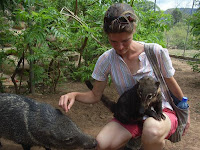
There was also a small zoo which I walked out to, and found myself becoming the climbing frame for friendly monkeys and other animals... stop licking my knee wild pig!
When it came to getting back to Santa Cruz, I was planning on catching a passing microbus, but got invited by two merry Bolivian 
Villa Tunari
Theres this wildlife refuge run staffed mainly by volunteers that has rescued large cats, monkeys, a bear and more, that I saw on the internet. To be a volunteer you need to stay a minimum of 2 weeks so with that out I decided to drop in and have a look for an afternoon instead. What I found was a small town on the side of the highway and a lovely refuge overrun by friendly volunteers. Two looking after a Bolivian bear (endangered), and many more looking after cats, monkeys and birds. I spent a few hours watching and playing with their monkeys, and chatting to volunteers.
Cochabamba
On to another major Bolivian city on my way back to La Paz, and this one known for its large sprawling market, and its palace built for a tin barron. I checked out the markets succumbing to another woven blanket-rug, lots of fruit juices, and nibbles too. The palace was stunning with a gorgeous interior and lovely gardens, and rather out of place in Bolivia as it wasnt colonial style... supposedly based on Versaille. But it really showed just how much money was made from mining here... all imported marble, furniture and statues, silk wallpaper etc.
A few more photos when I get a chance
Sucre
 Sucre is a beautiful white colonial city, with heaps of churches, convents, a thriving market, parades and a lovely green town square.
Sucre is a beautiful white colonial city, with heaps of churches, convents, a thriving market, parades and a lovely green town square. Since I was staying across from the market, I adopted the habit of getting myself a delicious fresh fruit salad and smoothy to start the day. And couldnt help but be impressed by the hum of this busy area... open first thing in the morning, and a popular pedestrian strip come 9 or 10pm.
Since I was staying across from the market, I adopted the habit of getting myself a delicious fresh fruit salad and smoothy to start the day. And couldnt help but be impressed by the hum of this busy area... open first thing in the morning, and a popular pedestrian strip come 9 or 10pm. I loved Sucre´s weaving museum, had to go back after lunch, and went back a few days later to buy myself some amazing hand woven pieces. I also checked various other museums, most of which were housed in lovely buildings.
I loved Sucre´s weaving museum, had to go back after lunch, and went back a few days later to buy myself some amazing hand woven pieces. I also checked various other museums, most of which were housed in lovely buildings.And for a change of pace I went to see some dinosaur footprints... yeah, the local cement factory were quarrying when they uncovered a whole slab of footprints going up a almost vertical wall. It used to be a muddy swampy area near a lake apparently, but a volcanic eruption covered it with protective ash, and the plates tilted rather a lot. Odd.
And just before I was leaving, I ran into a wierd parade around the town square... dancing teenagers followed by decorated cars..
 And I decided to fly between Sucre and my next destination as I couldnt face another overnight bus, and a half hour flight sounded oh so much better!
And I decided to fly between Sucre and my next destination as I couldnt face another overnight bus, and a half hour flight sounded oh so much better!
Friday, October 19, 2007
Potosi - silver mines
 Potosi is the worlds highest city according to my guidebook, and it also has an amazing history due to its silver mining. Yes, once the worlds most prolofic and lucrative silver mine starting in the 1500s, it grew by the end of the 1700s to be the largest and wealthiest city in Latin America. Yes, the spaniards loved their silver. And they ordered locals to work for months at a time in the mines, and then went on to import african slaves as well. Of course conditions were appalling (and still are) and with shifts of 12 -18 hrs a day and months at a time underground it was hardly
Potosi is the worlds highest city according to my guidebook, and it also has an amazing history due to its silver mining. Yes, once the worlds most prolofic and lucrative silver mine starting in the 1500s, it grew by the end of the 1700s to be the largest and wealthiest city in Latin America. Yes, the spaniards loved their silver. And they ordered locals to work for months at a time in the mines, and then went on to import african slaves as well. Of course conditions were appalling (and still are) and with shifts of 12 -18 hrs a day and months at a time underground it was hardly  surprising millions died. The church even went as far as to revoke its previous order that all coca leaves were prohibited due to pressure from the mine owners... workers needed coca leaves to work those hours.
surprising millions died. The church even went as far as to revoke its previous order that all coca leaves were prohibited due to pressure from the mine owners... workers needed coca leaves to work those hours.Since its glory days, Potosi is now in trouble after 500yrs of mining the quality of ore is not great and hardly economic... it relies on tin and lead at the moment, and the forecast reserve is for these is only another 10 to 20 years.
Anyway I wandered round town, checking out the beautiful colonial buildings, churches, convents etc. (Nuns also led an odd life I discovered, being shut away behind wooden doors and only allowed to speak to

 family once a month and only hear them not see them then either) And the next day I went on a mine tour.
family once a month and only hear them not see them then either) And the next day I went on a mine tour.Well, first of all we got all suited up cos its dusty and dirty down the mines (quite probably poisonous too with the lead and arsenic...). Then we went to learn basic bomb making in the miners market... where anyone (yes kids, foreigners, anyone) can buy supplies of dynamite, ignition fuses and other materials that help make bigger bangs! Of course you can also get face masks,
 lamps and safety gear (although I cant say I saw that much in use). From there we went to get more presents for the miners... coca leaves and soft drinks. (Check out the lump in the vendors cheek... a lump of coca leaves) Then a visit to a ingenio where they grind and refine the ore a little. (Oddly they export the dried sludge, and don`t smelt any here)
lamps and safety gear (although I cant say I saw that much in use). From there we went to get more presents for the miners... coca leaves and soft drinks. (Check out the lump in the vendors cheek... a lump of coca leaves) Then a visit to a ingenio where they grind and refine the ore a little. (Oddly they export the dried sludge, and don`t smelt any here)Then down the mine for 2-3 hours, through the maze of tunnels that have been carved in the mountain. No real planning here...
 groups of miners follow mineral veins and prop where they think necessary... no big picture, no overall company controlling mine, no OH&S, minimal machinery with the majority being shovelled out of the mountain and put into rail carts. Groups of miners get paid according to the ore quality and quantity. Did I say it was hot and dusty down the mines...and at times only crawlable. It was a real experience to visit the place and see the conditions they work in, but let me tell you its hot, hard to breath and uncomfortable, a few hours and one shovel load was more than enough for me. But very interesting.
groups of miners follow mineral veins and prop where they think necessary... no big picture, no overall company controlling mine, no OH&S, minimal machinery with the majority being shovelled out of the mountain and put into rail carts. Groups of miners get paid according to the ore quality and quantity. Did I say it was hot and dusty down the mines...and at times only crawlable. It was a real experience to visit the place and see the conditions they work in, but let me tell you its hot, hard to breath and uncomfortable, a few hours and one shovel load was more than enough for me. But very interesting.At the end our guide demonstrated how the dynamite works... so casually lighting it and then handing it round with a burning fuse for photos (see
 left... thats lit) before running down the hill to explode it somewhere safe! Yeah it went bang.
left... thats lit) before running down the hill to explode it somewhere safe! Yeah it went bang.On a different note I caught a micro out to a wierd hot springs up a mountain in this beautiful valley. It was a little freaky cos I was the only one there, and the guidebooks warned about the dangers of swimming there. Its this round green pool, volcanic with really steep sides that just dropoff, and no ones quite sure how deep it is but it gets hotter the deeper you go. And bubble come up in the
 centre of the laguna. Now if thats not a setting for some wierd nasty creature from a horror movie I dont know what is... needless to say I swam but warily!
centre of the laguna. Now if thats not a setting for some wierd nasty creature from a horror movie I dont know what is... needless to say I swam but warily!Tuesday, October 16, 2007
Tupiza...wild west?
 From Uyuni I finally got to go on a Bolivian train - to Tupiza and to arrive at the very inconvenient time of 4am. So I had planned on sleeping in, and then a bit of a lazy day looking round the city and surrounding canyon.
From Uyuni I finally got to go on a Bolivian train - to Tupiza and to arrive at the very inconvenient time of 4am. So I had planned on sleeping in, and then a bit of a lazy day looking round the city and surrounding canyon.What I discovered when I ventured out was that it was market day, so I spent a few hours wandering along looking, and sampling some of the saltenas (like pasties - mainly potato with a bit of chicken and spice), tamales (corn balls with llama meat inside),
 and freshly squeezed orange juice.
and freshly squeezed orange juice.Then up to the lookout to see how the town is nestled between red and greenish grey spectacular rocky mountain ranges. And I couldnt help but notice how much warmer it is than La Paz or Uyuni... spose the lower elevation helps. I then decided to explore one of the canyons nearby, so I headed up this valley which narrowed with stunning red rock formations on both sides. It was fun following the canyon, discovering wierd
 formations round every bend. And further up the canyon got quite narrow, requiring a little scrambling over rocks to continue. And did I mention the cactuses... I guess its them which makes me think of the wild west ... plus the fact that Butch Cassidy and the Sundance Kid died a few town along after robbing a payroll. One of the tourist attractions is to ride horses and visit the cave they hid in, the hotel they stayed in... wierd but it is lovely countryside. I would have spent another day exploring on horse and bike except there wasn`t any other tourists interested so no tour... so goodbye to cheap and friendly Tupiza and onwards to Potosi for me.
formations round every bend. And further up the canyon got quite narrow, requiring a little scrambling over rocks to continue. And did I mention the cactuses... I guess its them which makes me think of the wild west ... plus the fact that Butch Cassidy and the Sundance Kid died a few town along after robbing a payroll. One of the tourist attractions is to ride horses and visit the cave they hid in, the hotel they stayed in... wierd but it is lovely countryside. I would have spent another day exploring on horse and bike except there wasn`t any other tourists interested so no tour... so goodbye to cheap and friendly Tupiza and onwards to Potosi for me.Monday, October 15, 2007
Salt flats, volcanoes, deserts, lakes and flamingos

 I headed for the southern corner of Bolivia to Uyuni and its salt flats, and the amazing Eduardo Avaroa Reserve. Wow... the scenery is stunning!
I headed for the southern corner of Bolivia to Uyuni and its salt flats, and the amazing Eduardo Avaroa Reserve. Wow... the scenery is stunning!After a bumpy overnight bus ride down to Uyuni (I had wanted to go by train in the day, but it was
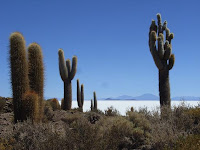 cancelled due to a blockage due to a political protest), I wandered round town, and bumped into Matt Fishbeck at the market!
cancelled due to a blockage due to a political protest), I wandered round town, and bumped into Matt Fishbeck at the market!I´d already signed up for a 3 day tour in a 4wd in La Paz, and I found myself in a very ¨international¨ car with 2 Canadians, 2 italians, a Columbian, and our Bolivian driver and cook. We headed out to the train graveyard, and then out to the salt flat and this small town that used to be a railway town but now barely survives refining salt. No shortage of salt of course, just its hardly
 worth enough to bother transporting it! So now carved salt souvenirs bring in a bit of money.
worth enough to bother transporting it! So now carved salt souvenirs bring in a bit of money. From there we went further south, into
 stunning volcanic high plains and deserts, with wierd rock formations, sand and stones. And wierd animals like rabbits but with bushy tails. And Vicunas eating god knows what in the desert... There are these spectacular coloured lakes, teeming with flamingos. Which contradicts all my instincts that flamingos live in tropics! We´re talking lakes of about 4000m altitude with temperatures dropping below freezing overnight (down to -30 apparently at times), but they don´t freeze due to their wierd mineral mix.
stunning volcanic high plains and deserts, with wierd rock formations, sand and stones. And wierd animals like rabbits but with bushy tails. And Vicunas eating god knows what in the desert... There are these spectacular coloured lakes, teeming with flamingos. Which contradicts all my instincts that flamingos live in tropics! We´re talking lakes of about 4000m altitude with temperatures dropping below freezing overnight (down to -30 apparently at times), but they don´t freeze due to their wierd mineral mix.
 And a geyser and field of boiling mud at 5000m altitude, and a wonderfully warm hotspring for a quick soak before breakfast! Onto more lakes (and the most spectacular greenish blue one which may look pretty but is a poisonous mix of chemicals including lead and arsenic), and more wierd
And a geyser and field of boiling mud at 5000m altitude, and a wonderfully warm hotspring for a quick soak before breakfast! Onto more lakes (and the most spectacular greenish blue one which may look pretty but is a poisonous mix of chemicals including lead and arsenic), and more wierd  rocks before a long drive back to Uyuni. Unfortunately we had 2 flats on the way back and only one spare tyre... so we waited for another 4wd to help us out. They´re all quite friendly from the different companies, with drivers helping out on various engine/tyre problems.
rocks before a long drive back to Uyuni. Unfortunately we had 2 flats on the way back and only one spare tyre... so we waited for another 4wd to help us out. They´re all quite friendly from the different companies, with drivers helping out on various engine/tyre problems.So what a trip! Spectacular scenery, lovely people, good food... all i´d say is it would be nice to be able to spend a bit longer at some of the places! Next time hey... But I`m not as crazy as some who were riding
 bicycles across some of
bicycles across some of  those barren deserts...
those barren deserts...
